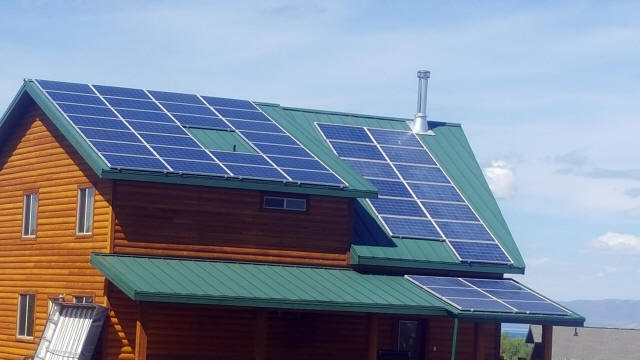Do-It-Yourself Solar Panel Installation

Deciding whether to install solar panels or a solar power system on your home can be a difficult decision. I was a skeptic like many others and didn't want to install solar just because it was 'Green' or because you see billboards saying how wonderful it is. Everyone's reasons are different but I'm an engineer and like to see the numbers make sense. If there is a 20yr payback period that seems pointless, for me even 5 or 10 years is questionable. This 10KW solar system is generating positive cash for us the first year. We took advantage of local power company incentives and federal tax credits in 2016 which worked out great. Since our cabin has a geothermal system for heating and cooling, electric water heaters, and hot tub everything runs on electricity. Being able to reduce or eliminate our electric bill means our utility costs for the cabin will be next to nothing. There are tons of options to choose from when picking out solar equipment but I'll show you the approach we took. Installing solar panels is definitely something you can do yourself and after doing it we found the whole project was much easier than I ever expected. First let's examine the numbers because if it doesn't save you money in reasonable timeframe why bother.
STEP 1: Solar Power - Do the numbers make sense?
In Utah, Rocky Mountain Power (RMP) has a solar incentive program where you apply for a lottery and if selected they will pay you an incentive based on the size of the system you install. Details can be found here:
https://www.rockymountainpower.net/env/nmcg/usip.html
These were the incentive rates available in 2016 from Rocky Mountain Power.
| Category | Incentive Cap | Incentive Per Watt |
|---|---|---|
| Residential | 4 kW(AC) | $1.10 |
| Small Non-Residential | 25 kW(AC) | $0.85 |
| Large Non-Residential | 1,000 kW(AC) | $0.65 |
As you can see a typical residential household would be capped at $4400 on the incentive but since our cabin is a business and the power bills are paid by the LLC we qualified as a small non-residential which meant we could receive an $8606 incentive (225W x 45 panels = 10,125W * 0.85 = $8606).
There were several program requirements that had to be met for the Rocky Mountain Power incentive which are outlined in their FAQ section if you are interested. In general you apply and once accepted you get a building permit and have the system inspected when you are done. Once you pass inspection, RMP returns and installs a net meter which allow you to receive credit for excess power you feed back into the grid. You must purchase panels and inverters that meet minimum requirements specified by RMP.
Federal Solar Incentives
In addition to the Rocky Mountain Power Incentive, homeowners can take advantage of Federal Tax Credits outlined here: http://energy.gov/savings/residential-renewable-energy-tax-credit
The federal solar taxes credit amounts are listed below:
- 30% for systems placed in service by 12/31/2019
- 26% for systems placed in service after 12/31/2019 and before 01/01/2021
- 22% for systems placed in service after 12/31/2020 and before 01/01/2022
- There is no maximum credit for systems placed in service after 2008.
- Systems must be placed in service on or after January 1, 2006, and on or before December 31, 2021.
- The home served by the system does not have to be the taxpayer’s principal residence.
State (Utah) Solar Incentives
Many states offer solar incentives or tax credits as well. Here is a link to the solar incentives available in Utah in 2016 when we installed:
http://energy.utah.gov/funding-incentives/financing-for-infrastructure/
Utah offers a renewable energy systems tax credit worth 25% of eligible system cost or $2,000, whichever is less, for residential installations, and 10% of eligible system cost or $50,000, whichever is less, for commercial installations. Eligible technologies include solar photovoltaic, solar thermal, wind, geothermal, hydro, and biomass.
Cost Breakdown of Solar Project
Approximate cost breakdown for our solar electric system:
- Solar Panels $6750 (45 x $150ea)
- Inverters $3,750
- Mounting hardware, wiring, misc $1500
- Labor $0
- Total: ~$12,000
As you can see after the $8600 incentive from Rocky Mountain Power, 30% Federal Tax Credit, and 25% State Tax Credit we were not out of pocket much at all. You could always buy higher end panels and inverters but for us this equipment worked great and kept the budget in line.
Compare the numbers here with some of the big name solar installers who are advertising a similar sized system for $30-50k and you can see there's a dramatic price difference. Even though the large installers may advertise zero down or keep your current electric payment for life you are basically paying off another small mortgage for 20 or 30 yrs with that company and often times they own the equipment installed on your roof. There are a lot of crazy sales tactics out there to get people to buy into these residential solar systems but many of them just do not make financial sense. DIY solar can make a lot of sense financially, especially if you can find incentives on top of the federal and state tax credits.
STEP 1: Solar Power - Do the numbers make sense?
STEP 2: Designing Your Own Solar Power System
STEP 3: Installing Solar Panels on Metal Roof
STEP 4: Connecting Solar Inverters
